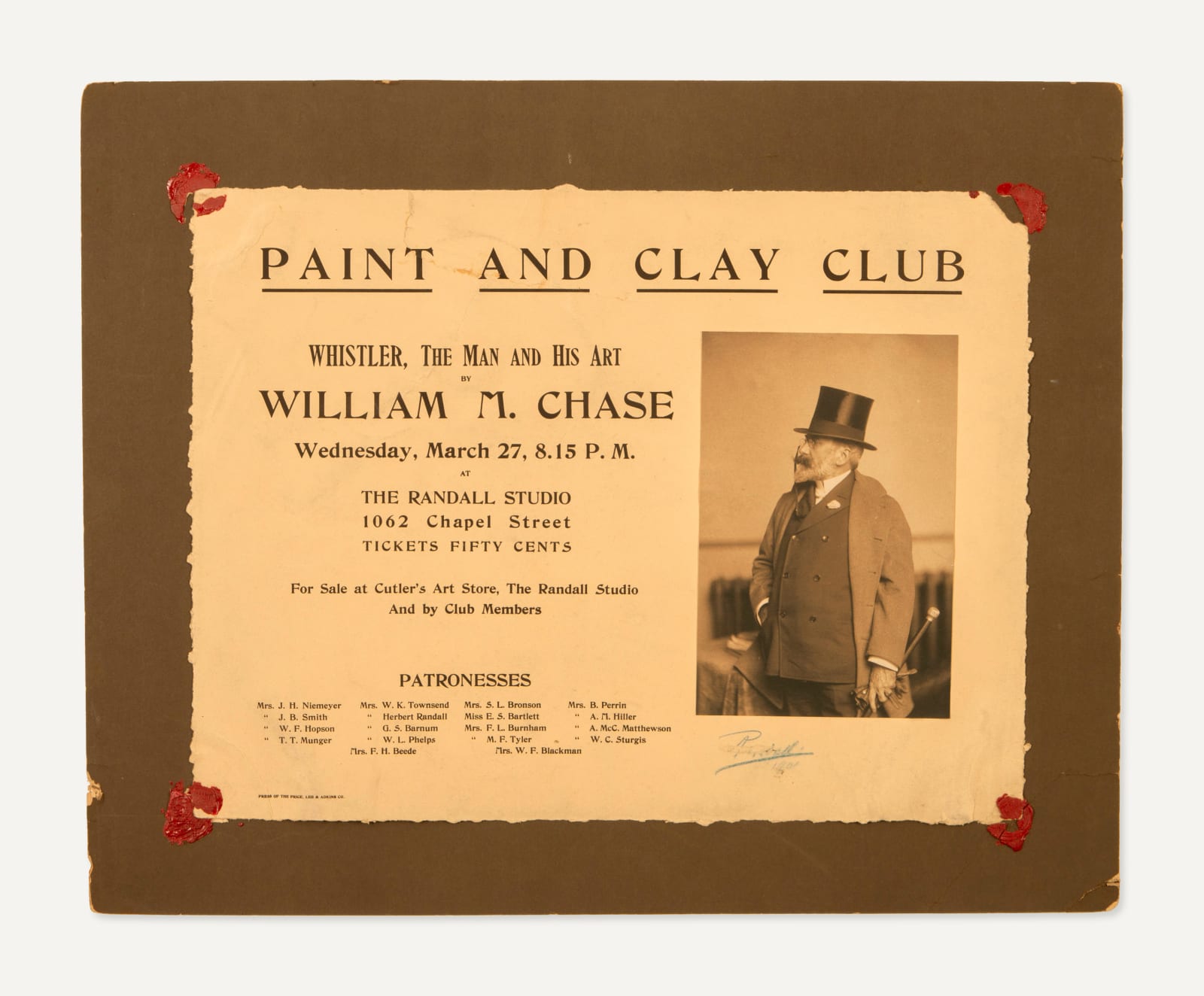Randall Studio
Photographically-Illustrated Broadside Advertising a Lecture on Whistler by W.M. Chase, c. 1901
Platinum print affixed to paper
20 x 25 inches overall
Broadside with affixed platinum print photograph, attached to board with red wax.
With Randall's signature recto.
Broadside with affixed platinum print photograph, attached to board with red wax.
With Randall's signature recto.
$ 3,600.00
A large and handsome broadside advertising a lecture entitled “Whistler, the Man and His Art” which was delivered by William Merritt Chase at the photo studio of Herbert Randall in...
A large and handsome broadside advertising a lecture entitled “Whistler, the Man and His Art” which was delivered by William Merritt Chase at the photo studio of Herbert Randall in New Haven, Connecticut, and was sponsored by the city’s Paint and Clay Club. The advertisement also lists the patronesses of the lecture, and is illustrated by a stately portrait of Chase which was taken by Randall.
American artists William Merritt Chase and James McNeill Whistler had, to put it simply, a complicated relationship. They met in the 1870s. Chase was already an admirer of Whistler, who was more than ten years his senior and already very well-known. At first they struck up a friendship and at one point agreed to paint each other’s portrait, with the intention of exhibiting the two together. Chase painted a full size portrait of Whistler which he called “The Public Whistler.” For this work, Chase departed from his typical vibrant painting technique and mimicked Whistler’s muted colors and style. In the meantime, the two men’s relationship began to strain as they traveled together and argued frequently. The final straw was Chase showing his portrait of Whistler without the latter in New York. The press coverage of the show presented the painting as an accurate ridiculing of Whistler’s likeness and style, and Whistler was insulted and declared himself finished with Chase and their friendship. Whistler’s portrait of Chase has never been shown and in all likelihood was destroyed.
Beginning around 1901, in what could perhaps be understood as an attempt to rewrite history, or at least sway public perception of their relationship, Chase began to tour with a lecture on his one-time close companion. Titled, “Whistler: Man and his Art.” Though he spoke of Whistler’s hot-tempered nature, the lecture was by all accounts a warm one. One review, published in the Morris County Chronicle in 1902, recounts that Chase “gave an interesting description,” of Whistler, “consisting of personal reminiscence and criticisms on his many works” and that Chase, “set forth the character of the man by his loyal devotion to art.” Whistler passed away in 1903, and Chase continued his talks until the end of the decade.
American artists William Merritt Chase and James McNeill Whistler had, to put it simply, a complicated relationship. They met in the 1870s. Chase was already an admirer of Whistler, who was more than ten years his senior and already very well-known. At first they struck up a friendship and at one point agreed to paint each other’s portrait, with the intention of exhibiting the two together. Chase painted a full size portrait of Whistler which he called “The Public Whistler.” For this work, Chase departed from his typical vibrant painting technique and mimicked Whistler’s muted colors and style. In the meantime, the two men’s relationship began to strain as they traveled together and argued frequently. The final straw was Chase showing his portrait of Whistler without the latter in New York. The press coverage of the show presented the painting as an accurate ridiculing of Whistler’s likeness and style, and Whistler was insulted and declared himself finished with Chase and their friendship. Whistler’s portrait of Chase has never been shown and in all likelihood was destroyed.
Beginning around 1901, in what could perhaps be understood as an attempt to rewrite history, or at least sway public perception of their relationship, Chase began to tour with a lecture on his one-time close companion. Titled, “Whistler: Man and his Art.” Though he spoke of Whistler’s hot-tempered nature, the lecture was by all accounts a warm one. One review, published in the Morris County Chronicle in 1902, recounts that Chase “gave an interesting description,” of Whistler, “consisting of personal reminiscence and criticisms on his many works” and that Chase, “set forth the character of the man by his loyal devotion to art.” Whistler passed away in 1903, and Chase continued his talks until the end of the decade.
